#arabian folklore
Text
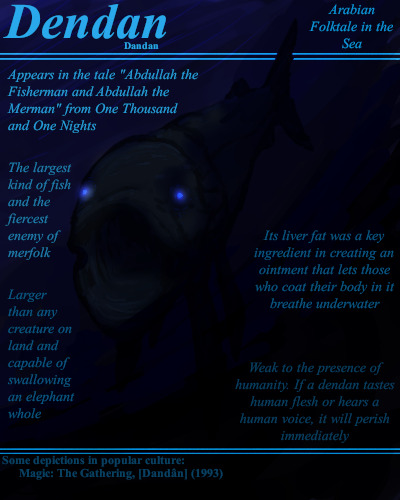
Humanity need not fear the biggest fish, for it knows them and fears them.
#BriefBestiary#bestiary#digital art#fantasy#folklore#legend#folktale#arabian folktale#arabian folklore#sea monster#dendan#dandan#one thousand and one nights#abdullah the fisherman and abdullah the merman#arabian nights
33 notes
·
View notes
Note
what is that djinn who pretends to be a boatsail? :O you can not find a lot about djinn online, only same 3 to 4 types plus DnD contamination :(
Ohoho you’re asking about Khattaf Raffay (خطّاف رفّاي)!
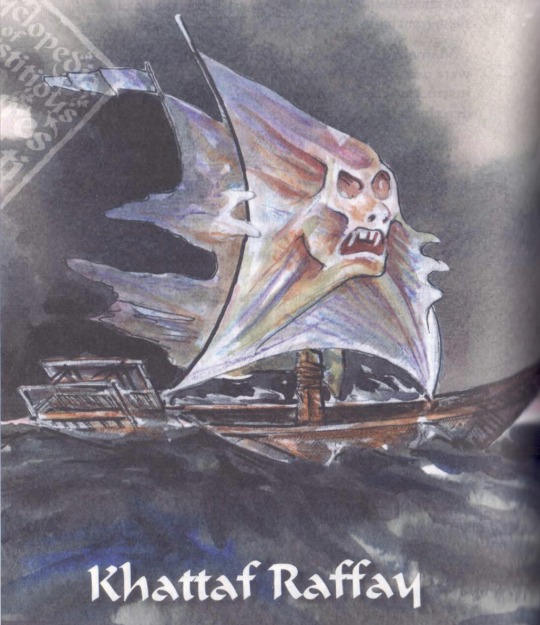
His name has some weird derivations online, but its real origin is from the up and down movement of a sail (يخطف و يرفي, yakhtuf wa yarfi). So you could roughly say it means “he who flaps like a sail”.
He looks like a great white triangle sail, sometimes with a boat attached; it is also unclear whether he wears the sail or is the sail. He haunts the sea where the water is deepest. He crashes down on ships and breaks them in two, or leads them astray until they are lost at sea. On land he is less dangerous but no less terrifying.
Fortunately for everyone, he’s cleaned up his act enough that he is now the star of an Emirati children’s book, where he’s not evil, just misunderstood!
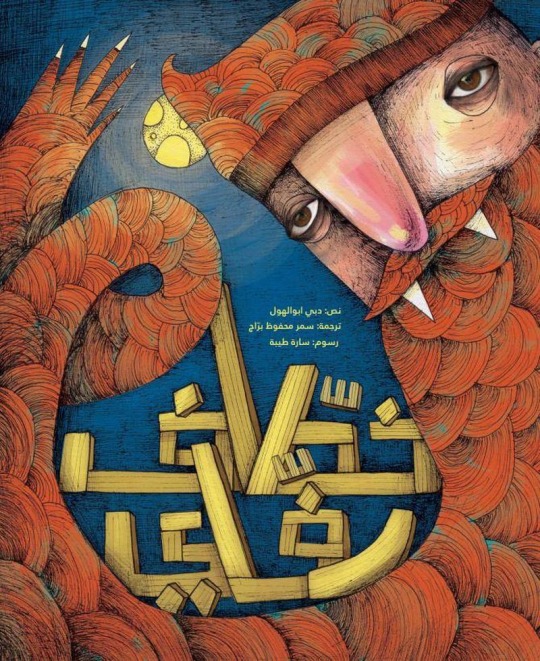
Reference and image
al Musallam, A. (2017) Emirati Superstitious Creatures. Sharjah Institute for Heritage, Sharjah.
#khattaf raffay#jinn#jinni#united arab emirates#emirati superstitious creatures#emirati folklore#arabian folklore
50 notes
·
View notes
Text

First five issues are free till New Years! now you can go read it if you haven’t yet. https://aishathani.gumroad.com
49 notes
·
View notes
Text
#aliyaaaepel3 polls#tumblr polls#polls about Wartb villians#aliyaaaepel3 posts#tell me? ;)#donkey lady#hemarat al gayla#a genie#werehyena#arabian folklore#Al tantal
13 notes
·
View notes
Text
Season 3 of Residents of Proserpina Park has mythological tricksters, character development, and uh, oh right, me! I’m in this season too.

Season three of @proserpinapark has been something really special. We got twelve episodes rather than the usual ten, we got to meet the tricksters of the park, and the voice actors gave fantastic performances. Oh, and I got to be one of those voice actors.
When we last left our heroes, they had just come to a shocking revelation: the park is named Proserpina Park! Oh, and Sam is back. That’s also pretty important. Ah, but Sam isn’t alone. He’s joined by an old friend named Jessica. She has a freewheeling devil-may-care personality, and a very cavalier when it comes to the creatures of the park. Jessica is back to settle some old business. Business that Dog, the gang’s loyal alien in canine disguise, has some connection to. It has something to do with a particularly mysterious creature.
Alina and her friends are going to have to venture into the depths of the park to find answers. They must be sure to keep their wits sharp. For, in this season, we shall meet the tricksters who call the park home. Meanwhile, Mirai is having her own adventures in Japan. She has found her way to a village populated by yoaki. She’s certainly out of place as a mere human, but she’ll make some unlikely allies during her time in the village. Everyone buckle up, because this season of Residents of Proserpina Park is sure to be a wild ride.
In the immortal words of John Lennon, you get by with a little help from your friends. That is a major theme of this season. It is repeatedly emphasized how Alina’s friends, Drew and Jun, help to reign in Alina and dial back her impulses.
Jessica, a new character from this season, also emphasizes the theme of friendship. She does so as a foil to Alina. Jessica is, essentially, how Alina would have turned out if she didn’t have her friends, or if she had alienated them. Jessica tends to rush in first, and ask questions later, if at all. She tends to focus on whether she can do something, rather than if she should do it. Jessica is determined to become the most powerful being in the park. It doesn’t matter how many creatures she has to hurt to achieve this.
We also get to learn more about Drew and Jun’s backstories this season. We learn that Drew tried college, decided it wasn’t for them, dropped out, and doesn’t have any concrete plans in life. They’re just going wherever the winds of fate take them. Drew is well aware that they will probably part ways with Alina and Jun one day. However, they don’t despair. It isn’t how much time they have with Alina and Jun, but how they spend it that matters. Even if they must part ways eventually, Drew will always have Alina and Jun’s backs.
This is quite a thoughtful and introspective moment from what tends to be a fairly lighthearted audio drama. It rings very true to my own experiences.
Naturally, we get to meet all sorts of amazing new creatures from across World Mythology and Folklore. I had been hoping we might meet Anansi, the trickster spider god of the Akan people, at some point. Lo and behold, this season more than delivered on that. Vincent C. Davis gave such an absolutely wonderful performance. He sounded almost exactly how I always envisioned Anansi sounding. It was pitch-perfect casting. I loved getting to meet the wemategunis. It is a creature from the folklore of the Lenape people. I always appreciate getting to learn more about Native American cultures. I was also pleasantly surprised that we got an entire episode devoted to Mirai’s adventures in Japan. I had been hoping we might get something like this at some point.
Let’s see, what am I forgetting? Oh, right, I’m in this season too. I got to voice Slenderman. He was included as an example of a creature form modern day folklore. This was the first major voice acting role that wasn’t a bit part. I’m very excited that I actually got to be part of Residents of Proserpina Park. I had a lot of fun voicing Slenderman. Angela Yih said she envisioned Slenderman sounding like God from Puppet History of the Universe. So, I tried to mimic that style. I love the distorted sound-effects that Angela included for the parts where Slenderman really shows his true colors. And hey, who knows, maybe you’ll get to hear me again when season four rolls around.
I don’t know what direction season four of Residents of Proserpina Park will be heading, it can’t wait to find out. Season three introduced so many amazing new creatures, but also have character development to the humans. The future is looking very bright for Residents of Proserpina Park.
Have you listened to season three of Residents of Proserpina Park? If so, what did you think?
Link to the original review on my blog: https://drakoniandgriffalco.blogspot.com/2023/08/the-audio-file-residents-of-proserpina.html
And here’s the links to my reviews of the first two seasons of you haven’t checked those out
Season One: https://drakoniandgriffalco.blogspot.com/2021/08/the-audio-file-residents-of-proserpina.html?m=1
Season Two: https://drakoniandgriffalco.blogspot.com/2022/04/the-audio-file-residents-of-proserpina.html?m=1
#review#audio fiction#audio drama#residents of proserpina park#mythical creature#mythical beasts#mythology#folklore#Slenderman#creeypasta#Japanese Mythology#Japanese Folklore#Arabian Folklore#Akan Mythology#West African Mythology#Anansi#Irish Mythology#Irish Folklore#mythical creatures#mythology and folklore#Podcast#fiction podcast#urban fantasy#fantasy#fantasy fiction#Lenape Mythology#chinese mythology#audio drama recs#audio drama review#audio drama podcast
3 notes
·
View notes
Text
Deadly fall: Ghouls
GHOULS
Category: Arabian folklore
The term “ghoul” has become pretty popular nowadays, and designs any kind of random undead/flesh-eating creature. But “ghoul” originally was a very specific kind of creature: the ghûl of Arabia.
In Arabic folklore, a “ghûl” (also known as a “ghoul” if you Westernize it) is a monstrous humanoid creature. Ghouls are said to live in cemeteries, abandoned places and deserts : the “lifeless” places. They will prefer cemeteries due to the presence of corpses: for you see, a ghoul is always hungry. Their favorite food is of course human beings : if someone wanders into wastes or ruins without being well-protected, the ghouls might feast on them. Sometimes they eat the flesh, sometimes they just drink the blood – children are apparently especially tasty to them. But given they live in such arid and feared areas, most of the time ghouls feed on corpses and dead flesh – hence their preference for living in cemeteries. Ghoul’s great appetite and carnivorous habits were actually so well-known in the Arabic world that figuratively, you could call “ghoul” a noticeably gluttonous or greedy individual.
Another important point about the ghouls is that they are shape-shifting entities. Most of the time they turn into various desert animals to feast on their victims or enjoy their corpsy meals : hyena is their favorite and most common shape. They can also use their transformation abilities to lure clueless travelers or unprotected humans into their lair, where they will be at their mercy: some even say that ghouls can take the shape of the person that was their last meal. Typically ghouls are male, though female ghouls do exist: called “ghulah”, they tend to act as an archetypal “fairytale-like” character, the same way for example Baba-Yaga acts in Slavic fairytales. The female ghoul will usually be one given entity luring men to their death, and referred to by a “familiar” name such as “Mother Ghoul” or “Aunt Ghoul”. Some however claim that ghouls have no real gender, and just switch between male and female depending on the type of victim they try to lure.
While ghouls certainly come from a pre-Islamic Arabian folklore, they were still “adopted” and absorbed into the Muslim beliefs, though with the peculiar result of sparking a debate about their exact nature: the question is, are ghouls a type of jinn or a type of shayatin? This is very important… A jinni (that would become “genie” in English) is a type of supernatural entity that is thought to be the original inhabitants of Earth, the first species of mortal beings created by God before He crafted mankind. The jinn are known to be a being made of “smokeless fire” (aka energy), unlike men made of earthy materials (aka flesh), and as a result they are notorious for being otherworldly, invisible when they want to, in tune with nature and gifted with magical powers (they can be assimilated from monsters and ogres to fairies and nymphs). But they are still a lot like men: they are mortal entities, they exist in the material world, and they have free will (some chose to be virtuous and good, others are bad and vile, some chose religion – and it can be any kind of religions – while others reject it, etc…). If a ghoul is a jinni, it means that 1) they can be killed and are still mortal beings, and 2) they are entities that chose to be evil, that went into this lifestyle of free will, but that also can have changes of heart and become more righteous and rightful entities. Some versions of the tale precisely say that it is because they rebelled against God and the forces of good, while siding with all evil creatures, that ghouls were banished to far-away and isolated places: the mountains, the valleys, the deserts…
But… they might be shayatin, aka demons. A “shaitan” is indeed an immortal evil spirit not belonging to the material world and fully intended on causing as much harm as it can do – and since they are in Islam’s theology the polar opposite of angels, you can translate them as “demons”. If indeed the ghouls are part of this kind of entities (which some do think, as it is known that prayers can repel the ghouls), then it completely changes their nature. One particular story tells of a “fallen angel-like” backstory for the ghouls : originally the ghouls were, like the rest of the shayatin, heavenly spirits that co-existed with angels. But they had a nasty habit of making profit out of their stay in Heaven: they spied on the angels and on God to learn all their secrets, and then went to Earth to reveal all this top-secret information to various soothsayers, witches and false prophets. God, greatly displeased with such behavior, slowly banished them from Heaven : as it was made of seven spheres, he first closed them off to the three highest spheres around the birth of Jesus, but given the shayatin kept doing their bad stuff, when the prophet Muhammad was born he just closed all of the spheres to the shayatin, banishing them away from Heaven. But a group among them, even more rebellious and arrogant than the rest, decided to still return to Heaven despite God’s interdiction, sneaking back their way in. It was a BAD idea. God sent comets to cut their travels: burning comets. HIGHLY burning comets. A good chunk of these spirits were burned to utter destruction by these supernatural comets, and the ones that survived were both severely disfigured by the burns and rendered insane from this demonstration of God’s power. Falling back on Earth, these deformed and mad spirits became the ghouls, now forever roaming the Earth as nothing more than corpse-eating beasts.
- - - - - -
Ghouls first became known to the European world thanks to the translation in French (well… adaptation/translation/rewriting) of the “One Thousand and One Nights”, though another work that was very key to introducing ghouls in the Western world was “Vathek” by William Beckford. A very unique end-of-the-18th century novel that was the first and stays one of the most well known “Orientalist Gothic” novels. You heard it right: with Vathek Beckford tried to mix the traditional Gothic novel with the Orientalist art/culture wave that had swept Europe, resulting in the beautifully grim and bizarre tale of a tyrannical and hedonistic caliph with a wicked witch for a mother, who after encountering a cryptic prophecy and a mysterious devil-like merchant, starts a long journey to his own doom passing by murderous plots, religious disputes, child sacrifices and shape-shifting jinn.
13 notes
·
View notes
Text

The recent ghoul discourse made me think of this. Quite a few years ago I read in a mythical creature book that the earliest recorded version of the ghoul had one eye, and I drew the image that that created in my mind. I later read another mythical creature book that clarified that the early ghoul was a one-eyed bird, which ruined everything.
#lee sherman#artists on tumblr#ghoul#monster#monocular#horned humanoid#arabian#arabian folklore#folklore#fantasy art#horror
1 note
·
View note
Text

Léon Georges Jean-Baptiste Carré (1878 ~ 1942) 1926 illustration for 'The Book of One Thousand and One Nights'
#Léon Georges Jean-Baptiste Carré#Léon Carré#The Book of One Thousand and One Nights#Leon Carre#One Thousand and One Nights#Arabian Nights#1920s#Middle Eastern folktales#Middle Eastern fairy tales#folktales#fairy tales#fairytale#fantasy#folklore#fairy tale illustration#vintage art#vintage illustration
94 notes
·
View notes
Text

The Sultan orders to cut off Aladdin's head by Albert Robida
#aladdin#scimitar#art#albert robida#illustration#aladdin and the wonderful lamp#one thousand and one nights#1001 nights#arabian nights#folklore#folk tales#fairy tales#chains#sword#oriental#middle eastern#executioner#swords#folk tale#hanna diyab#china#chinese#the book of the one thousand and one nights#the arabian nights#antoine galland#mythology#asia#asian#sultan
45 notes
·
View notes
Text

ARABIAN NIGHTS’ ENTERTAINMENT Edinburgh: Gall & Ingals, c.1870) Color engravings on steel.




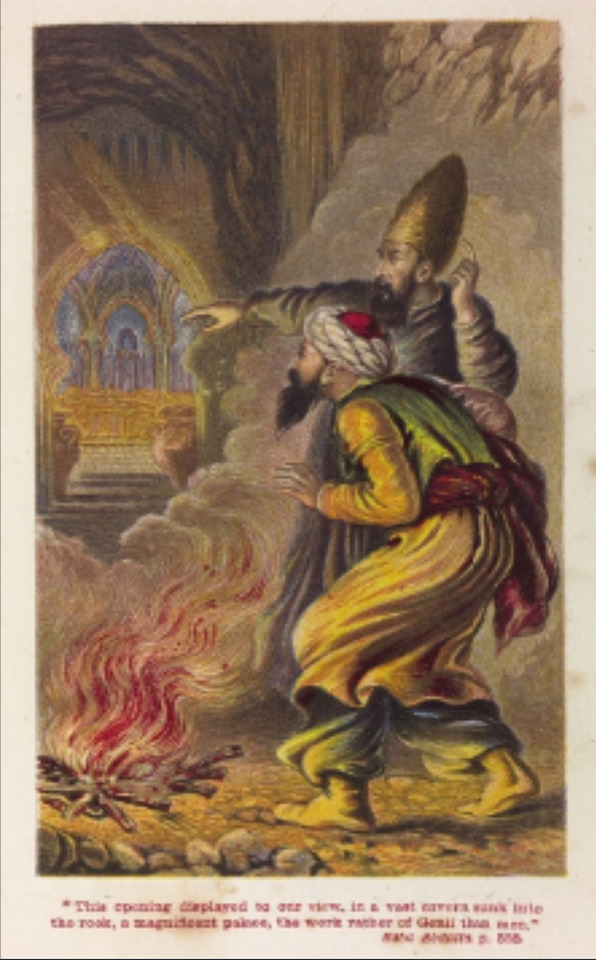
#beautiful books#book blog#books books books#book cover#books#vintage books#illustrated book#children’s book#victorian era#arabian nights#steel engravings#folklore#book design
30 notes
·
View notes
Text

Aicha Kandicha from Moroccan folklore.
Aicha Kandicha is often portrayed as a beautiful young woman with legs resembling those of a hoofed animal, like a goat or camel. While descriptions may differ across Morocco, the common belief is that she resides near water sources, using her beauty to entice and, in some accounts, drive local men to madness or death.
There's a consensus that Aicha Kandicha targets young men, luring them with her beauty or disguising herself as their wives. In specific regions like the Beni Ahsen, beliefs suggest she fears steel knives and needles, and she's associated with a husband or male companion known as Hammu Qayyu.
According to the Buffis, Aicha Kandicha is believed to don black attire, possess camel-like feet, and her presence can lead pregnant women to miscarry. Those under her influence might exhibit animal-like sounds such as braying or barking. Contrary to conventional burials, Aicha is said to lack a tomb or grave, with her spirit freely roaming. Local beliefs suggest that seeking her blessing fulfills the wishes of those who visit her.
Legend has it that Aicha Kandicha once blocked the path of men in villages, attempting to ensnare them with her allure. However, they cleverly escaped by burning their turbans in front of her, noticing her distinctive camel-like feet that set her apart from other women. The tale suggests that surprising her with fire is the only way to escape, as it is considered her vulnerability.
Follow @mecthology for more myths and lores.
Source: Wikipedia & mytindy.com
#mecthology#supernatural#folklore#morocco#arabian tales#scary#jinn#aicha Kandicha#creepy#dangerous#shape shifter#Moroccan tales#legends#follow
10 notes
·
View notes
Text
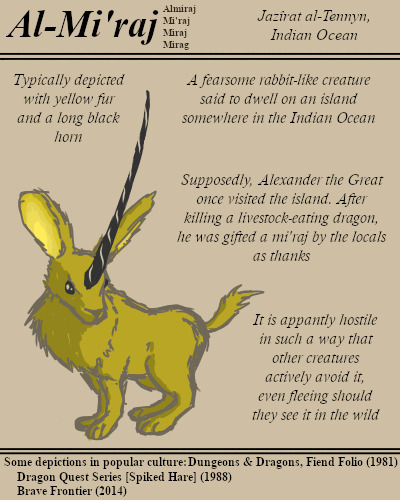
A strange creature, al-mi'raj appears to be a yellow rabbit with a long horn and a fearsome presence. It seems other creatures go out of their way to avoid its territory.
#BriefBestiary#bestiary#digital art#fantasy#folklore#legend#myth#mythology#al-mi'raj#mi'raj#mirag#miraj#jazîrat al-tennyn#arabian folklore#arabian legend#alexander the great#monster
44 notes
·
View notes
Text
This Halloween, make all ghouls look like this
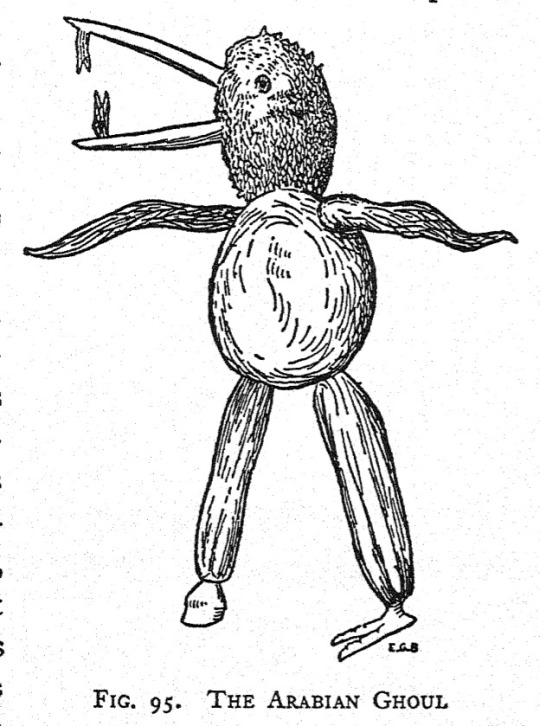
(From The Mythology of All Races: Semitic)
142 notes
·
View notes
Text
Interesting interpretation of a Qareen from Egypt

I know the Qareen as a spirit double and the Qareenah as another name for umm al subyan (who threatens young children and pregnant mothers)
#arabian folklore#Egyptian folklore#i need to work on the next issue but also i wanna do some world building 8(
8 notes
·
View notes
Note
debate: is Sheherazade a trickster?
in the original one thousand and one nights i would say absolutely. she's the one that comes up with the scheme to lull shahryar into passivity with her storytelling and thereby stop him from killing anymore girls. she's also explicitly described as being extremely intelligent and very learned. she fills the role of the trickster archetype as it tends to appear in these kind of narrative-framed folktales almost perfectly. and obviously we haven't seen a lot of her in neverafter yet but she's already shown an air of nonchalance in the face of dire situations, mixed with a cunning and quick-witted mind. so yes i posit that scheherazade is absolutely a trickster.
#scheherazade#tricksters#one thousand and one nights#arabian nights#folklore#fairy tales#neverafter#dimension 20#scheherazade neverafter#asks#swift-tricker's posts
39 notes
·
View notes
Text

“There was and there was not…”
Another idea from Discord, if Dream was a patron to The Bard he most certainly could have been one to Scheherazade, one of the greatest storytellers ever known. And honestly how could he not be drawn to the combination of beauty, bravery and creativity that is the teller of the 1,001 nights?
#based Scheherazade’s look on that of actress Mili Avital’s wonderful portrayal of her in the 2000 movie Arabian Nights#my art#dream of the endless#sandman#scheherazade#1001 nights#1001 arabian nights#arabian nights#fairytales#folklore#stories
66 notes
·
View notes